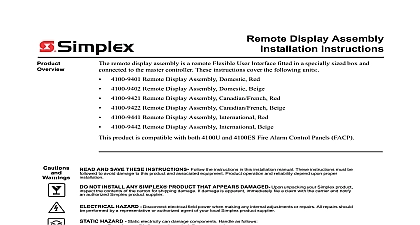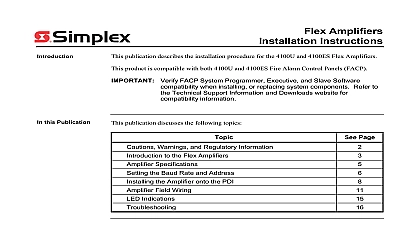Simplex Installation Instructions Remote Annunciators

File Preview
Click below to download for free
Click below to download for free
File Data
| Name | simplex-installation-instructions-remote-annunciators-1845203796.pdf |
|---|---|
| Type | |
| Size | 1.01 MB |
| Downloads |
Text Preview
Introduction publication describes the installation procedures for the following PIDs Remote Annunciators Instructions Remote Annunciator w Flexible User Interface Domestic Remote Annunciator w Flexible User Interface Canadian Remote Annunciator w Flexible User Interface International Remote Annunciator Basic Remote Annunciator Basic Remote Annunciator w Flexible User Interface Domestic Basic Remote Annunciator w Flexible User Interface Canadian Basic Remote Annunciator w Flexible User Interface International product is compatible with 4100U and 4100ES Fire Alarm Control Panels FACP Verify FACP System Programmer Executive and Slave Software when installing or replacing system components Refer to Technical Support Information and Downloads website for information this Publication publication discusses the following topics and Warnings Annunciator Installation Page Requirements 4100 9610 and 4100 9611 Requirements all models with Flexible User Interface Voltage Current Voltage Current VDC mA standby or alarm VDC mA standby 214 mA alarm Specifications Temperature to 120 F 0 to 49 C to 93 relative humidity at 90 F 32 C 2006 2011 SimplexGrinnell LP All rights reserved and other information shown were current as of publication and are subject to change without notice and the Simplex logo are trademarks of Tyco International Ltd and its affiliates and are used under license H and Warnings and AND SAVE THESE INSTRUCTIONS Follow the instructions in this installation These instructions must be followed to avoid damage to this product and associated Product operation and reliability depend upon proper installation NOT INSTALL ANY SIMPLEX PRODUCT THAT APPEARS DAMAGED Upon your Simplex product inspect the contents of the carton for shipping damage If is apparent immediately file a claim with the carrier and notify an authorized product supplier HAZARD Disconnect electrical field power when making any internal adjust or repairs All repairs should be performed by a representative or authorized agent of local Simplex product supplier SAFETY HAZARD Under certain fiber optic application conditions the optical output this device may exceed eye safety limits Do not use magnification such as a microscope other focusing equipment when viewing the output of this device HAZARD Static electricity can damage components Handle as follows yourself before opening or installing components to installation keep components wrapped in anti static material at all times RULES AND REGULATIONS PART 15 This equipment has been tested and found to with the limits for a Class A digital device pursuant to Part 15 of the FCC Rules limits are designed to provide reasonable protection against harmful interference when equipment is operated in a commercial environment This equipment generates uses and radiate radio frequency energy and if not installed and used in accordance with the manual may cause harmful interference to radio communications Operation of equipment in a residential area is likely to cause harmful interference in which case the will be required to correct the interference at his own expense REACCEPTANCE TEST AFTER SOFTWARE CHANGES To ensure system operation this product must be tested in accordance with NFPA 72 after any operation or change in site specific software Reacceptance testing is required any change addition or deletion of system components or after any modification repair adjustment to system hardware or wiring components circuits system operations or software functions known to be affected by a must be 100 tested In addition to ensure that other operations are not affected at least 10 of initiating devices that are not directly affected by the up to a maximum of 50 devices must also be tested and proper system operation 72 is a registered trademark of the National Fire Protection Association Annunciator Installation 4100 9607 9608 9609 9610 remote annunciators are configurable 4100U 4100ES Fire System Panels that provide annunciation and limited system control for remote areas The remote annunciator is used when LED Switch door modules are located in a cabinet A power supply SPS RPS etc is required Other 4100U 4100ES modules be located within the transponder cabinet The other three remote annunciators contain a User Interface which has a large screen LCD The remote annunciators are MINIPLEX 4100 9611 4100 9612 9613 and 9614 are not used with local power supplies Only modules are located in these cabinets Power is wired to the Transponder Interface 4100 9611 is for applications where LED Switch door modules are located in a cabinet The other PIDS include Flexible User Interface modules LED Switch may be added in the same cabinet when multi bay cabinets are used modules below are commonly located in Remote Annunciator cabinets Remote Command Center RCC The RCC 2x40 character LCD can display any trouble or supervisory condition The remote annunciator also provides basic user such as system reset alarm and acknowledgment for supervisory and trouble Not used with Flexible User Interface modules 4100 1289 LED Switch Controller with 4100 1276 to 1278 4100 1280 to 1287 Modules The LED switch user interface consists of a variety of display modules to the front of an expansion box that are configured via the Programmer Each display contains between 8 and 24 switches and LEDs Each switch and LED is separately Tamper Switch Wired to an input point programmed for annunciation when the door the cabinet is opened 9608 9609 9610 only 4100 1291 Remote Unit Interface Module Used to the length of communications wire to reach remote bays Only 1 level or RUI cascading is by the 4100U 4100ES architecture 9608 9609 9610 only 4100 1290 24 Point Graphic I O Module Allows up 24 inputs or outputs to be programmed and connected to the 4100 Fire Alarm Control Panel 24 points can be split up into any combination of inputs and outputs to meet customer RPS Expansion Power Supply XPS or Expansion System Power Supply Each RPS 24 VDC and 3 notification appliance circuits The SPS and RPS include a battery The SPS includes an IDNet channel controller These modules mount to the front of the bay and are restricted from mounting directly front of power modules due to physical interference on next page Annunciator Installation continued Setup annunciators are made up of several modules and each module has its own set of instructions The figures below and on the next page show the general setup for each annunciator Refer to the appropriate manuals to install specific modules Manuals are in the ship group for each module shown in the figures expansion bays with the power distribution interface PDI are always in the remote annunciator CPU bays are never used 1 4100 9607 9608 9609 9610 Remote Annunciator Installation Shown 2 4100 9611 9612 9613 9614 Basic Remote Annunciator Installation Shown The Remote Command Center is an option with 4100 9610 and 4100 9611 on next page Annunciator Installation continued for the Annunciator field wiring to 4100 9611 9612 9613 and 4100 9614 Remote Annunciators is 24V power RUI communications Refer to Figure 3 for wiring information 3 Wiring for 4100 9611 4100 9612 4100 9613 and 4100 9614 TIC Assembly on the the Remote Annunciator Annunciator Installation continued 4100 0620 TIC Assembly is used on the 4100 9607 4100 9608 4100 9609 and 4100 9610 annunciator Refer to Figure 4 for wiring information for the Basic 4 Wiring for the Basic Annunciator TIC Assembly


